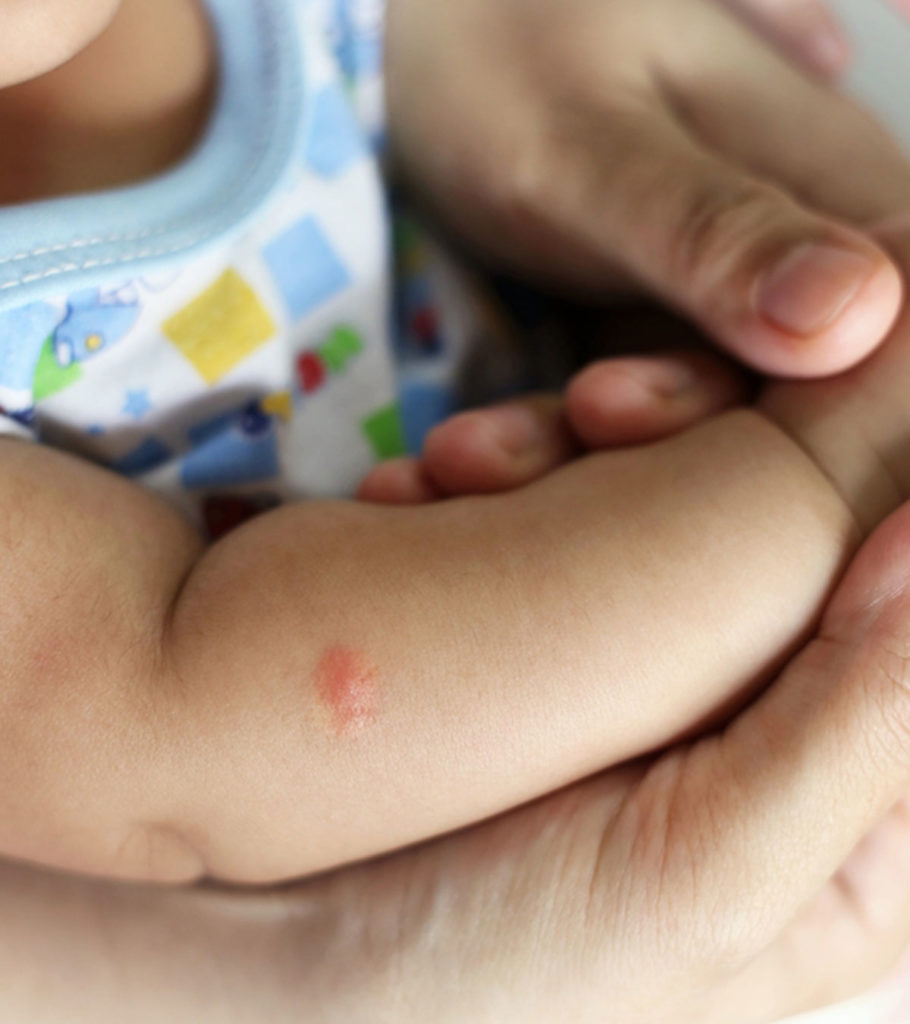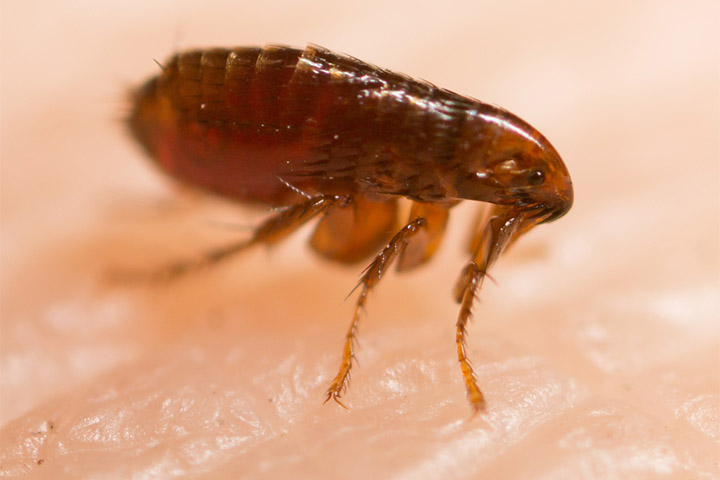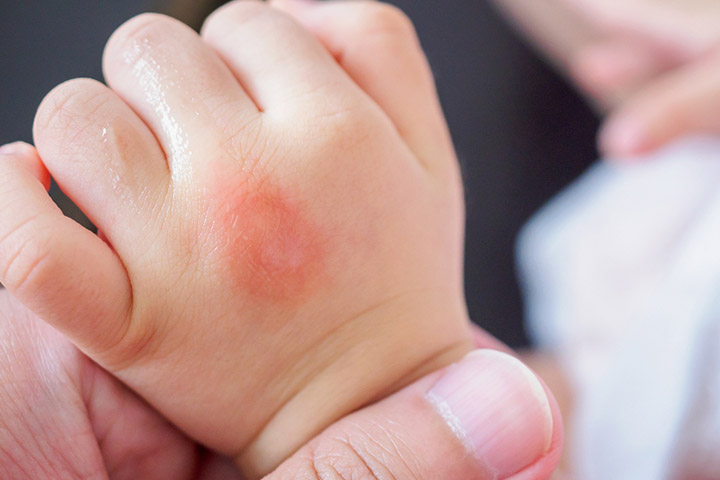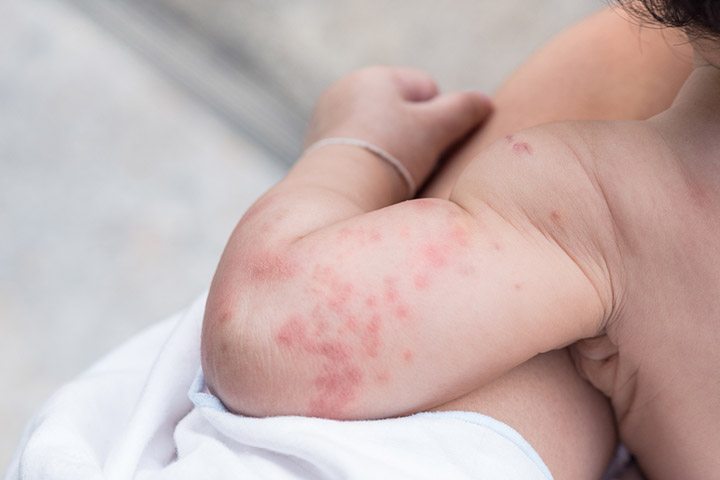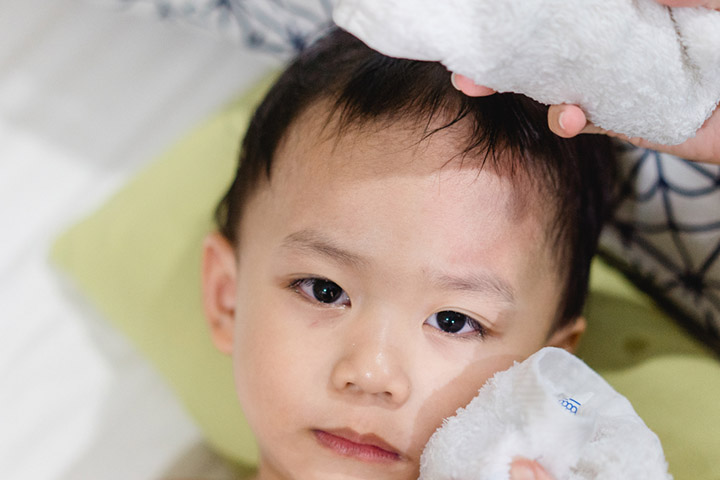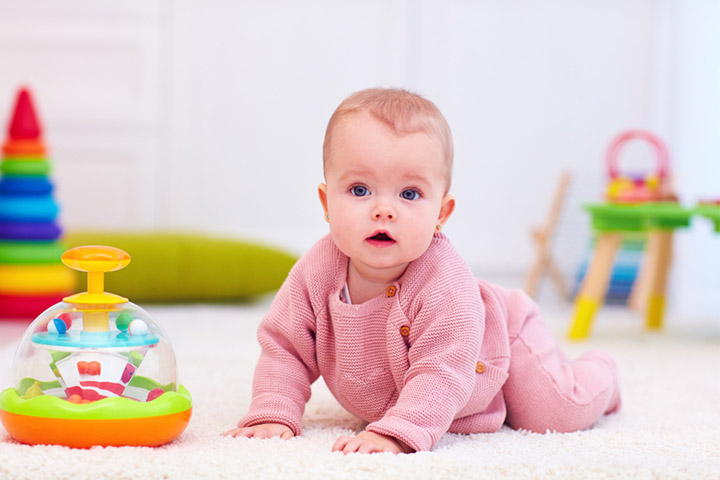Fleas may infest babies if they are unmonitored. Flea bites on babies may manifest as mild rashes to severe allergies, depending on their body’s response. As babies cannot clearly express their problems, pay close attention to their responses to stimuli. Observing your baby for any signs of fleabites is essential to help relieve symptoms and related discomforts at the earliest.
Read this post to learn more about what flea bites look like, how to prevent and treat them, and its consequences.
What Are Fleas?
Fleas are tiny parasitic insects that feed on the blood of warm-blooded animals. Usually found dwelling on the fur of animals, tall grasses, rugs, and doormats in the house, they are light brown to black and have a high reproduction rate. These are commonly seen during warm weather (1).
They can leap 50 times their body weight and get firmly attached to the skin to suck blood (2). Fleas can be killed by pesticide treatment of the house and by treating pets with appropriate pet-friendly medications.
What Do Fleabites Look Like?
Like bites from bedbugs, mosquitos, or ticks, flea bites can cause a considerable amount of discomfort in babies. Identifying fleabites is essential to decide the treatment and necessary actions to prevent future contact with insects. To look for flea bites, undress the baby from head to toe and check for the marks on the whole body, including scalp.
Flea bites can cause the following signs and symptoms.
- Inconsolable crying
- Itching
- Fever
- Small bumps with redness
- Clusters of few bumps or lines of redness (3)
- Bumps are sore, painful, and itchy
- Some children may develop blisters, swelling, hives, or rash around the fleabites as an allergic reaction (4)
- The common sites of fleabites are legs, ankles, groins, waist, buttocks, thighs, and lower abdomen (5)
Dr. Rosmy Barrios, a regenerative medicine expert, explains, “When a flea bite gets in contact with some substances, certain reactions begin in the body. One is the active release of histamine, a natural substance that triggers the immune response process. Because of histamine, the flea bites start to redden, swell, and itch.”
Complications Of Flea Infestations In Babies
Fleabites and the presence of fleas around the baby may lead to the following consequences and health complications.
- Scratching the fleabites may lead to fungal and bacterial infections, causing further complications.
- Fleas could carry bacteria, which could cause diseases, such as typhus and plague, in humans (6).
- Skin problems, such as dermatitisiXInflammatory skin conditions causing red rashes, dryness, and itchiness and allergic urticarialiXSwollen, itchy, and red bumps on the skin surface, have been reported in many cases of flea bites (7).
- Flea-borne typhus fever is a serious illness due to flea bites. It can cause fever, chills, vomiting, nausea, loss of appetite, and rashes, lasting for about a week (8).
- Infected fleas could indirectly spread cat scratch disease, which spreads in humans through cat bites or scratches (9).
- Human cases of plague due to flea bites are rare but, if affected, can be seen as sores and abscessesiXA condition marked by swollen, painful, pus-filled bumps, usually caused by bacteria in the glands of the arms and legs.
- Swallowing an infected flea may lead to intestinal tapeworms (10).
- Murine Typhus can also be caused by flea bites (10).
- Papular urticariaiXAn allergic reaction to insect bites causing painful lumps, sometimes filled with fluid affects children more than adults due to flea bites (11).
- TungiasisiXInflammatory skin disease caused by female sand fleas (Tunga penetrans) can be caused due to burrowing fleas (1).
Treatment For Fleabites In Babies
Wash the area with water and mild soap to avoid allergic reactions on the skin. Also, use any of these ways to relieve the symptoms of flea bites.
- Calamine lotion: It helps reduce allergic reactions, soothes the skin, and reduces signs of inflammation and itching.
- Over-the-counter ointments: Hydrocortisone creams help reduce skin reactions, allergies, and dermatitis (5). Do consult the child’s pediatrician before using any medicated products for the baby.
- Anti-allergic drugs: Doctors may prescribe antihistamine drugs to reduce the symptoms of flea bites (12).
In addition to the above treatments and medications, here are a few generally safe and mild home remedies that may help alleviate discomfort associated with flea bites in babies. - Nail-trimming: Cut the baby’s nails to avoid scratching and further worsening the condition with secondary bacterial or fungal infections (13).
- Cold compression: Place ice or cold water wipes over the flea bites to help reduce the soreness, redness, and itching.
- Aloe vera gel: It works as an anti-inflammatory and antibacterial product.
- Essential oils: Tea tree oil, sweet almond oil, rosemary oil, and coconut oils are known to help reduce itching and inflammation.
- Baby lotions: These soothe the skin and reduce itching.
- Oatmeal bath: Add colloidal oatmeal to a lukewarm bath and let the baby soak for a short period. Certain properties of oatmeal are believed to help relieve itching (12).
- Chamomile Tea Compress: Brew chamomile tea, let it cool, and use it as a compress on the bites. Chamomile’s anti-oxidant and anti-histamine properties may be soothing for the skin (14).
- Baking Soda Paste: Mix a small amount of baking soda with water to create a paste. Gently apply the paste to the flea bites and leave it on for about 15 to 20 minutes before rinsing with water (4).
If the signs of flea bites do not reduce or the baby is having a fever or seems to be dull, consult the doctor for appropriate treatment.
Preventing Flea Bites In Babies
Avoiding any contact with fleas is the best solution for babies. It can be done in the following ways.
- Find the source of fleas: If you frequently see fleabites on the child’s body, you have to find the source. It could be from the pets, construction sites, yard, unhygienic environment, heavy-wooded areas, or daycare facility for the baby. Treating these sources with anti-flea liquids, pesticides, and insecticides helps in preventing flea growth and infestation. Mowing the yard also helps reduce flea growth in the grass.
- Monitor the playground areas: If you take your baby out to a garden frequently, look for any fleas hidden in the grass. Walk around the place wearing white socks to catch the fleas.
- Cover the baby with clothes: During outdoor playtime, cover the baby with full-body clothes, such as onesies or bodysuits. You can also opt for socks and gloves for the baby. The aim is to cover the baby’s arms and legs without making the baby feel hot or suffocated. It will protect the baby from any insect bite.
Dr. Barrios says, “Although fleas often bite the legs and arms, they also really like thin skin. Babies’ skin is extremely thin and vulnerable, which attracts these insects even more.”
- Make pets flea-free: To identify if your pet is suffering from flea bites, look for signs such as scratching, hair fall, redness, or scabs on the pet’s skin (15). Anti-flea sprays and flea collars can be used for pets to get rid of fleas. Bathing your pets regularly with anti-flea shampoos will help avoid flea infestation. Maintaining good hygiene is essential when you have pets at home. Combing your pets routinely also reduces the chances of fleas building up in their fur. Do not allow pets in the baby’s bed, as fleas can get into rugs and sheets fur. Take the help of a veterinary doctor to free your pet from fleas.
- Go for pest control: Schedule a professional pest control program once a year or two in your home and surrounding area. You may have to shift to a different residence for a few days when pest control is going on, as it could cause an allergy.
- Clean the fabrics: Vacuum cleaning the doormats, rugs, carpets, fabric sofa covers, and other sheets is essential to get rid of any flea eggs or droppings. Treating such items with boric acid powder can help in preventing any insect build-up. Cleaning all suspected fabrics with warm steam is also an effective method (16).
- Use repellents: Insect repellent lotions can be applied over the body’s exposed areas when going out. Insect repellent fabric roll-ons and sprays can also be used to avoid any contact with fleas or other insects (8).
Babies are more susceptible to flea bites since they play, lie, and crawl on the floor. While the bites usually subside on their own (17). the greater risk is the diseases flea may cause, such as typhus and plague. While flea bites do not need medical intervention, certain home remedies for soothing irritated skin may be helpful to calm your baby. In addition, pesticide treatment can help you eliminate fleas from your home. If your pets get flea, groom them well and get them treated.
Key Pointers
- Flea bites can cause red bumps or lines, allergic reactions on skin, fever, and itching in babies.
- Fleas could spread bacterial diseases such as typhus and plague.
- Skin scratching can lead to fungal or bacterial infections.
- Calamine lotion, aloe vera gel, OTC ointments, and cold compression can relieve skin irritation and itching due to flea bites.
Are store-bought bug repellents safe to use for babies? Watch this video to find out. Also, learn what precautions you should exercise when applying and some holistic alternatives to these repellents.
